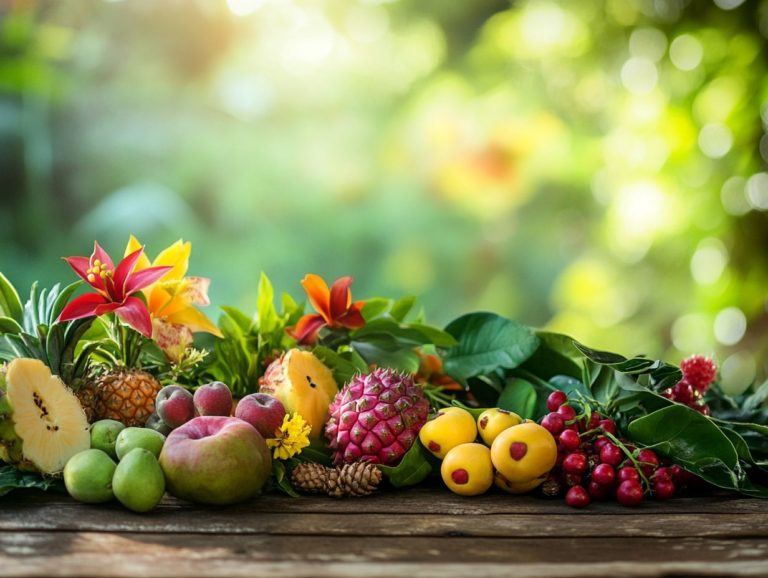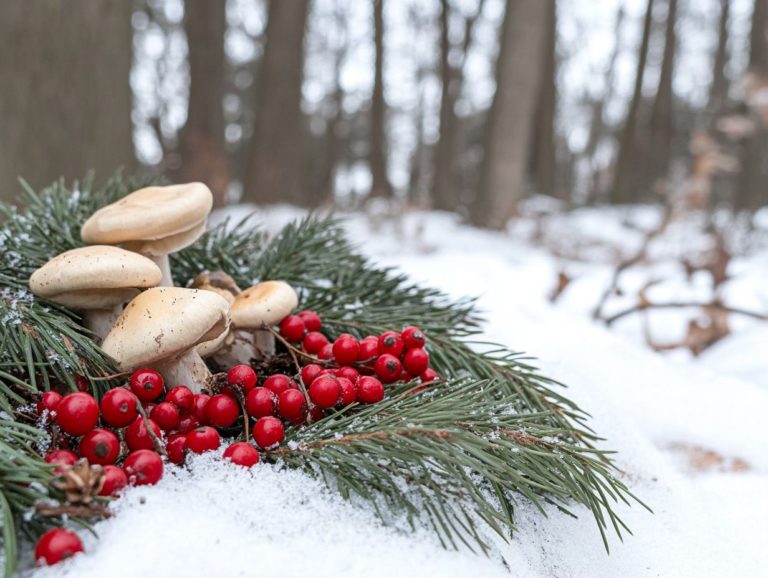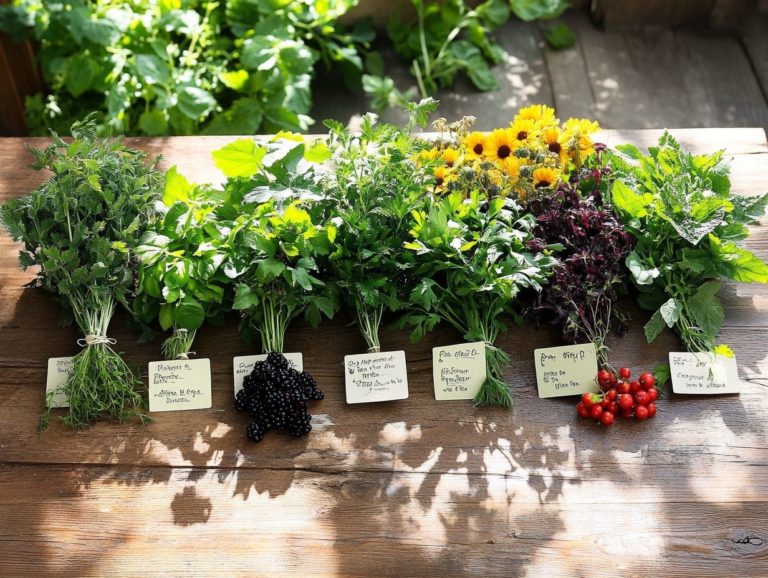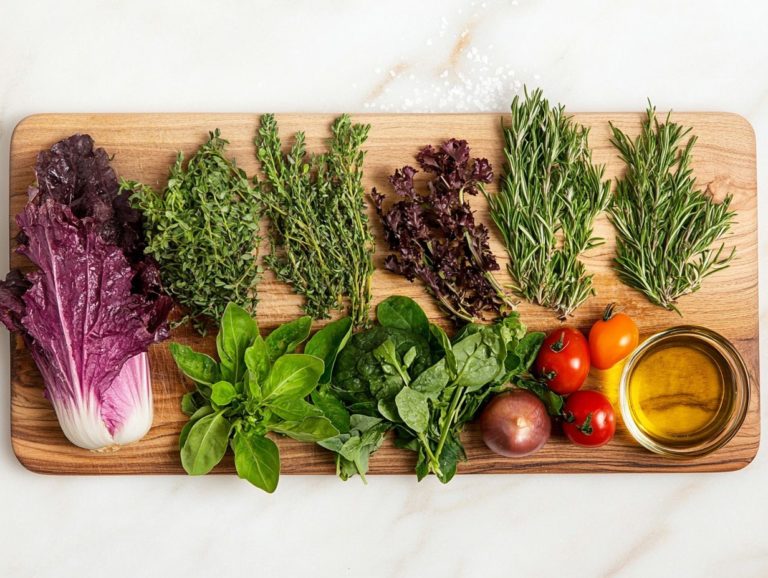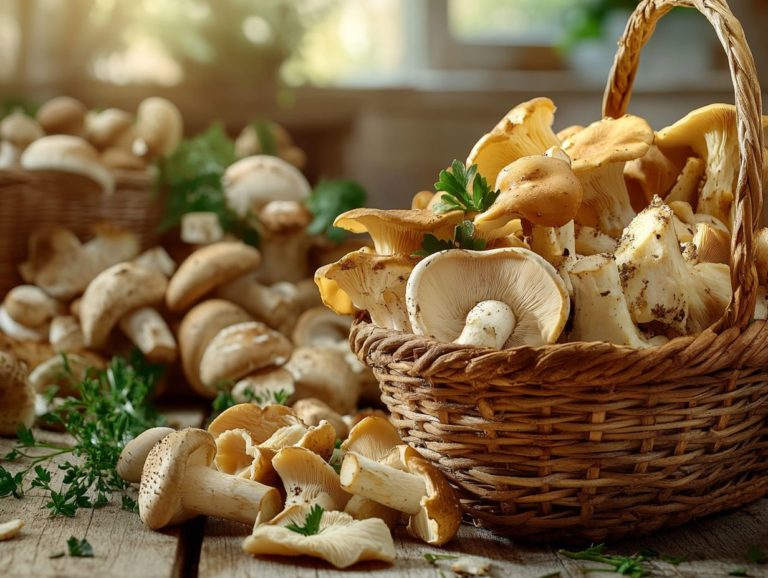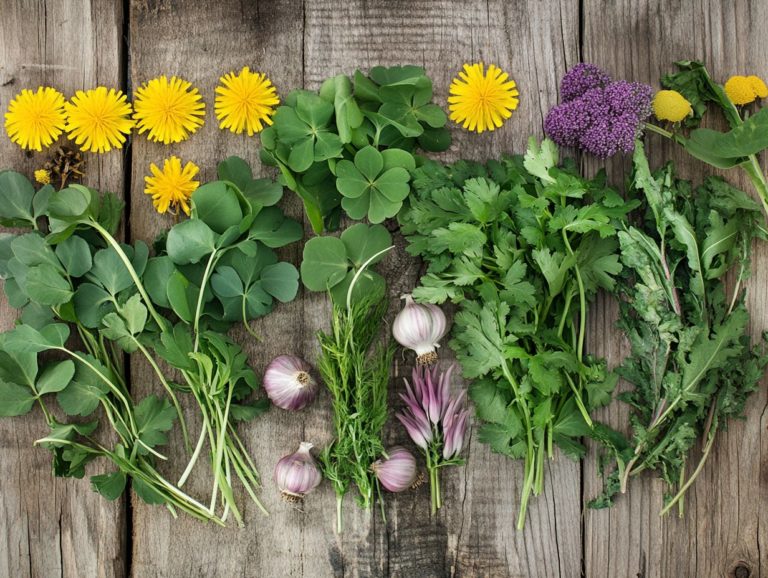The Benefits of Eating Wild Edibles
Wild edibles are nature’s hidden treasures, presenting a wealth of nutritional and medicinal benefits that you might often overlook, showcasing the natural power of foraging (which means gathering wild food from nature) in our daily lives.
From the vitamins and minerals nestled within wild greens to traditional uses that modern research supports, these wild plants have the power to enhance both your health and the flavors of your dishes, contributing to a healthful diet.
You can learn how to identify and safely harvest these natural gems through a foraging guidebook, along with practical tips for incorporating them into your meals.
Dive into the vibrant world of wild edibles and wild food, and unlock their potential for a healthier lifestyle through dietary diversity.
Contents
- Key Takeaways:
- Nutritional Benefits of Wild Edibles
- Medicinal Properties of Wild Edibles
- Identifying and Harvesting Wild Edibles
- Incorporating Wild Edibles into Your Diet
- Frequently Asked Questions
- What are the benefits of eating wild edibles?
- How do wild edibles compare to store-bought produce?
- Can foraging for wild edibles be dangerous?
- What environmental benefits come from eating wild edibles?
- Can wild edibles help with weight management?
- Are there any cultural or historical connections to eating wild edibles?
Key Takeaways:
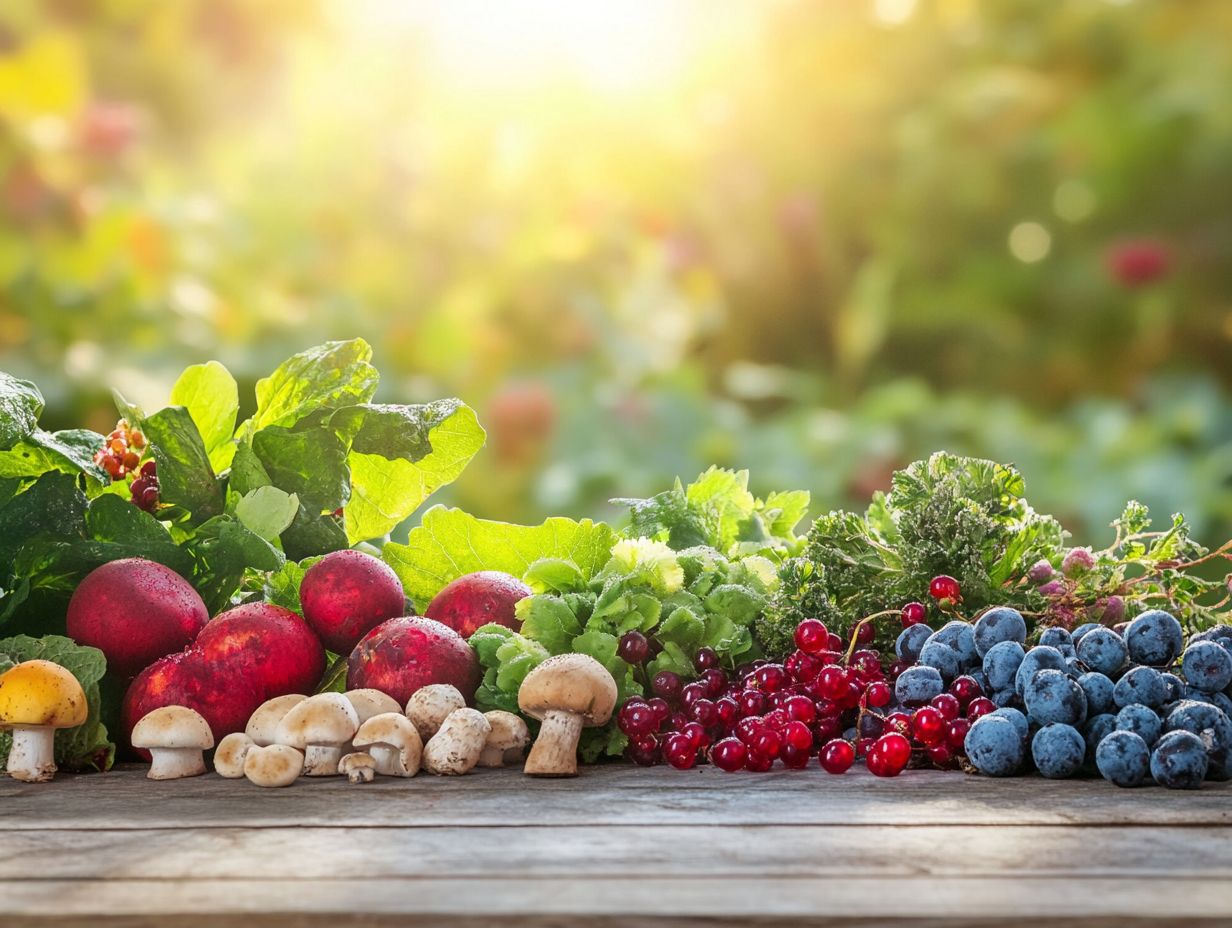
- Eating wild edibles, such as wild strawberries and wild leeks, can provide a variety of essential vitamins and minerals that are not found in traditional produce, making it a nutritious addition to any diet.
- Wild edibles have a long history in traditional medicine and Italian culture, and modern research has shown their potential health benefits, such as anti-inflammatory and immune-boosting properties.
- Learn how to safely use wild edibles in your diet. This practice connects you with nature and adds variety to your meals, promoting community nutrition.
What are Wild Edibles?
Discover the world of wild edibles and what makes them special. Wild edibles invite you to explore a diverse array of nutrient-dense plants that can be foraged from nature, creating an exhilarating connection between food diversity and traditional culinary practices. In cultures like Italian, the appreciation for wild foods is a cherished legacy passed down through generations. These edible plants not only offer unique flavors but also carry significant health benefits, positioning them as essential elements of sustainable food systems and community nutrition.
In many regions, foraging techniques are lovingly passed down through oral traditions, allowing you to connect deeply with your environment and understand local ecosystems. Italian foragers, for example, eagerly search the countryside for dandelion greens, nettles, or wild asparagus, celebrating the seasonal shifts in their cuisine.
Recognizing edible plants is more than just survival; it fosters a deep respect for nature’s diversity.
Incorporating wild edibles into your daily meals can ignite creative cooking, enabling chefs to harmonize rustic flavors with contemporary cuisines. This delightful fusion not only elevates the nutritional profile of dishes but also enriches your overall eating experience, especially with the benefits of permaculture in foraging.
Nutritional Benefits of Wild Edibles
Wild edibles pack a powerful punch of nutrition! These natural wonders are brimming with essential vitamins, minerals, and healthy plant compounds that significantly bolster your overall health and well-being. To discover more about this topic, check out the benefits of wild foraging.
For anyone looking to diversify their diet, they present an excellent option. By integrating these nutrient-dense foods into your meals, you can craft a powerful strategy to combat chronic diseases and enhance your immune system.
Vitamins and Minerals Found in Wild Edibles
Wild edibles present a treasure trove of essential vitamins and minerals vital for a balanced diet. You’ll find gems like Vitamin A, Vitamin C, iron, and calcium nestled within many wild plants. Foraging in urban areas for these nutrient-dense delights not only elevates your culinary experience but also supports community nutrition and champions a sustainable food system.
Take wild garlic, for instance; it s a standout with its impressive levels of Vitamin C and sulfur compounds, which may enhance heart health and bolster your immune system. Then there s wild asparagus, brimming with Vitamin K and folate, both essential for bone health and cellular functions.
By incorporating these greens into your daily meals, you not only bring a burst of flavor to your dishes but also make significant strides in your overall nutritional health. This underscores the importance of recognizing the gifts that nature offers and the role of local food in our diets.
Engaging with wild edibles cultivates a deeper appreciation for local ecosystems and highlights the benefits of seasonal foraging for your diet, promoting healthier dietary choices within your community.
Explore your local area for wild edibles and start your foraging adventure today!
Medicinal Properties of Wild Edibles
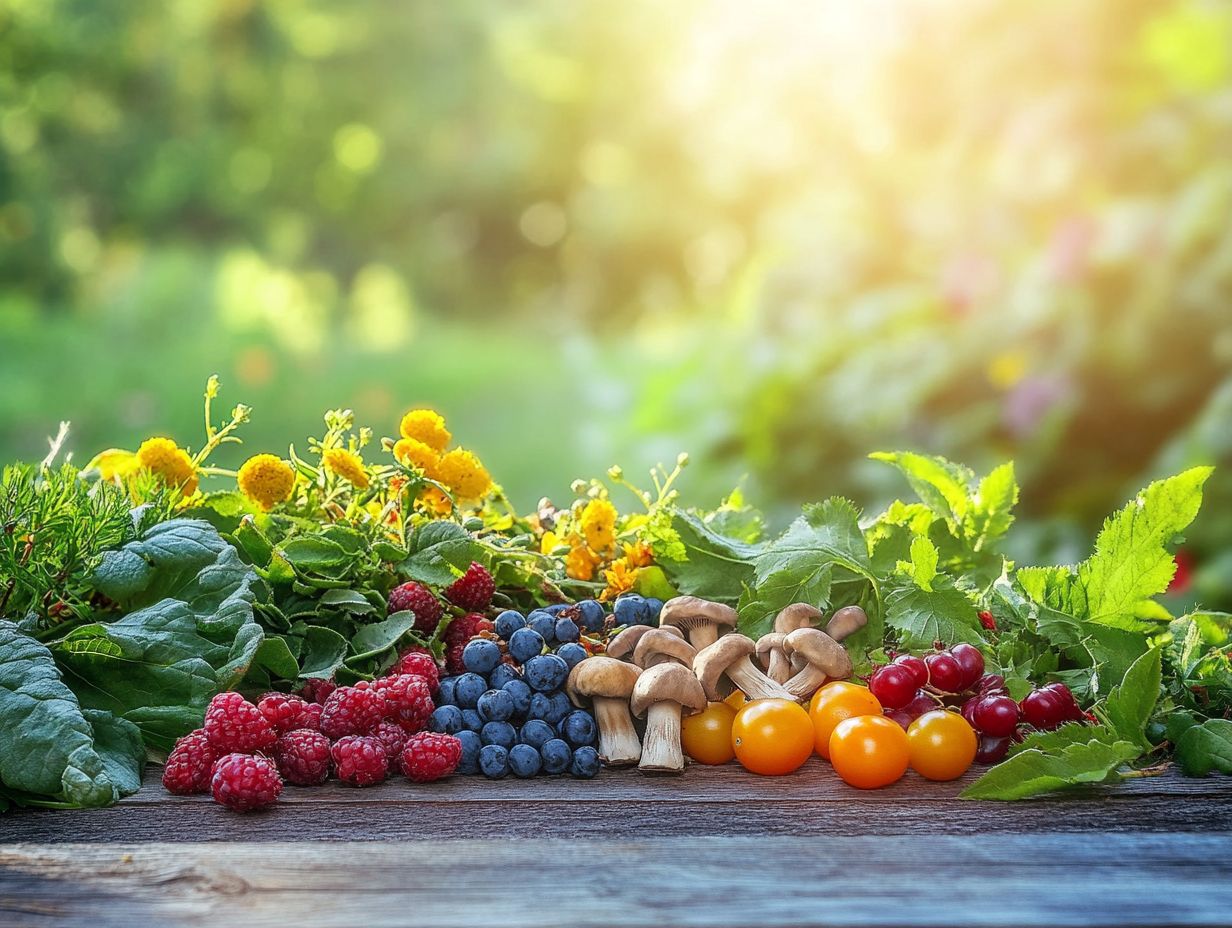
Wild edibles possess remarkable medicinal properties that have been cherished in traditional medicine for centuries. This underscores the profound relationship between humans and plants.
Imagine harnessing the benefits of dandelion greens for detoxification. Explore the potential immune-boosting effects of wild mushrooms. Discover the exciting treasure trove of natural remedies these plants offer, each contributing to a holistic approach to health and wellness that is as enriching as it is revitalizing.
Traditional Uses and Modern Research
The traditional uses of wild edibles have been documented across cultures, unveiling a treasure trove of herbal knowledge and a profound understanding of plant properties that modern research is now beginning to validate. This intersection between ancient practices and contemporary science highlights the vital role these plants play in community nutrition.
For centuries, diverse cultures have turned to wild edibles not just for sustenance but also as natural remedies for various ailments. Take dandelion greens, for example; Native Americans historically utilized them to address digestive issues. Meanwhile, stinging nettle has long been a staple in European herbal traditions for its impressive anti-inflammatory properties.
Modern studies are catching up to these age-old practices, validating the role of wild plants in community nutrition. Recent research confirms that wild edibles are far more than mere folklore; they are brimming with vitamins, antioxidants, and essential minerals. Findings published in the Journal of Ethnopharmacology spotlight the active ingredients in these plants that bolster immune health and may help mitigate chronic disease risks. This showcases how traditional wisdom maintains a scientific foundation that remains relevant in today s world.
Identifying and Harvesting Wild Edibles
Identifying and harvesting wild edibles demands your keen attention to detail and a solid grasp of foraging techniques. This not only ensures your safety but also promotes sustainability, creating a profound connection with nature during your outdoor adventures.
By understanding the distinct characteristics of edible plants, like wild blueberries and wild leeks, you can fully appreciate the abundant benefits these nutrient-rich foods offer.
Safety Precautions and Sustainable Practices
When foraging for wild edibles, safety comes first. Learn how to avoid toxic plants and embrace practices that protect our environment. It’s essential to grasp the environmental impact of foraging to delight in nature s bounty responsibly.
Always carry an herb identification guide with you. This handy tool helps you distinguish between safe and harmful species, significantly reducing the risk of accidental ingestion.
Stay alert to potential contaminants in your foraging areas think pesticides or polluted water sources. This awareness can safeguard your health and ensure that the plants you gather are uncompromised, reflecting the importance of environmental awareness.
Beyond personal safety, adopting sustainable foraging practices is key to preserving local habitats and biodiversity. This means:
- Only harvest what you need.
- Leave enough plants behind to grow back.
- Avoid taking too many of any one type of plant.
By following these guidelines, you foster a balanced ecosystem for future generations to enjoy.
Incorporating Wild Edibles into Your Diet
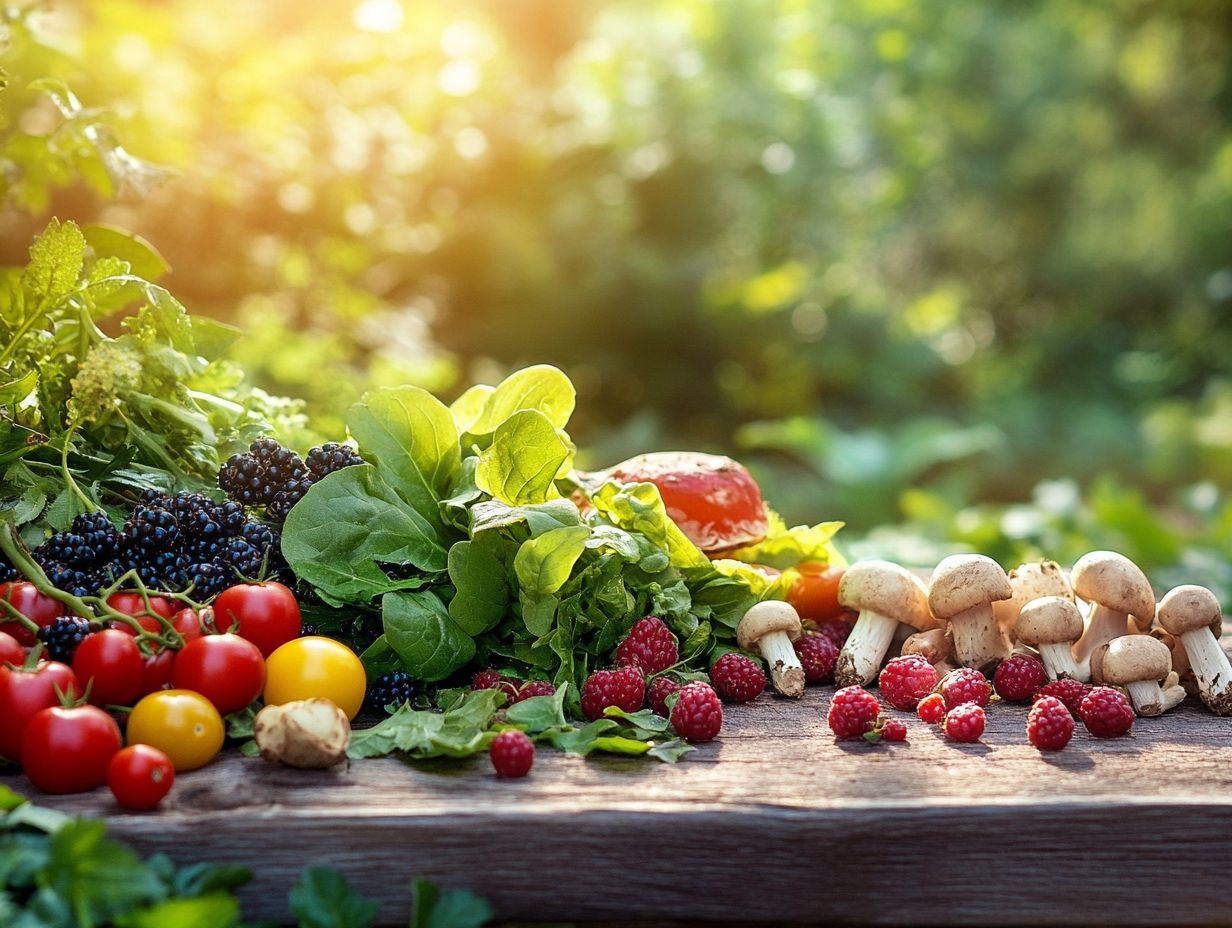
Incorporating wild edibles into your diet has the power to elevate your culinary creativity. They introduce unique flavors and health benefits that enhance traditional recipes while promoting a wholesome lifestyle.
Imagine adding wild garlic to a savory dish or featuring wild asparagus in a fresh salad. These remarkable plants not only diversify your meals but also create thrilling new dining experiences that delight the palate.
Try adding wild edibles to your meals this week and experience the health benefits for yourself!
Recipes and Cooking Methods
Foraged recipes that utilize wild edibles, including wild herbs and wild strawberries, offer you a remarkable opportunity to explore your culinary creativity. Experiment with flavors and ingredients sourced directly from nature.
By incorporating plants like wild strawberries and dandelion greens, your dishes benefit from enhanced flavors while showcasing the health benefits of fresh, organic ingredients.
Including foraged elements in your cooking adds unique tastes and promotes sustainability. Dive into exciting cooking methods like saut ing garlic mustard and making pesto from ramps!
Every foraged ingredient you discover is a chance to explore vibrant flavors while deepening your understanding of the local ecosystem. This adventurous approach encourages you to embrace a variety of textures and colors in your meals, ultimately celebrating seasonal abundance and fostering a greater appreciation for nature’s bounty.
Frequently Asked Questions
What are the benefits of eating wild edibles?
Wild edibles offer many health benefits, such as increased nutrient intake and better digestion.
How do wild edibles compare to store-bought produce?
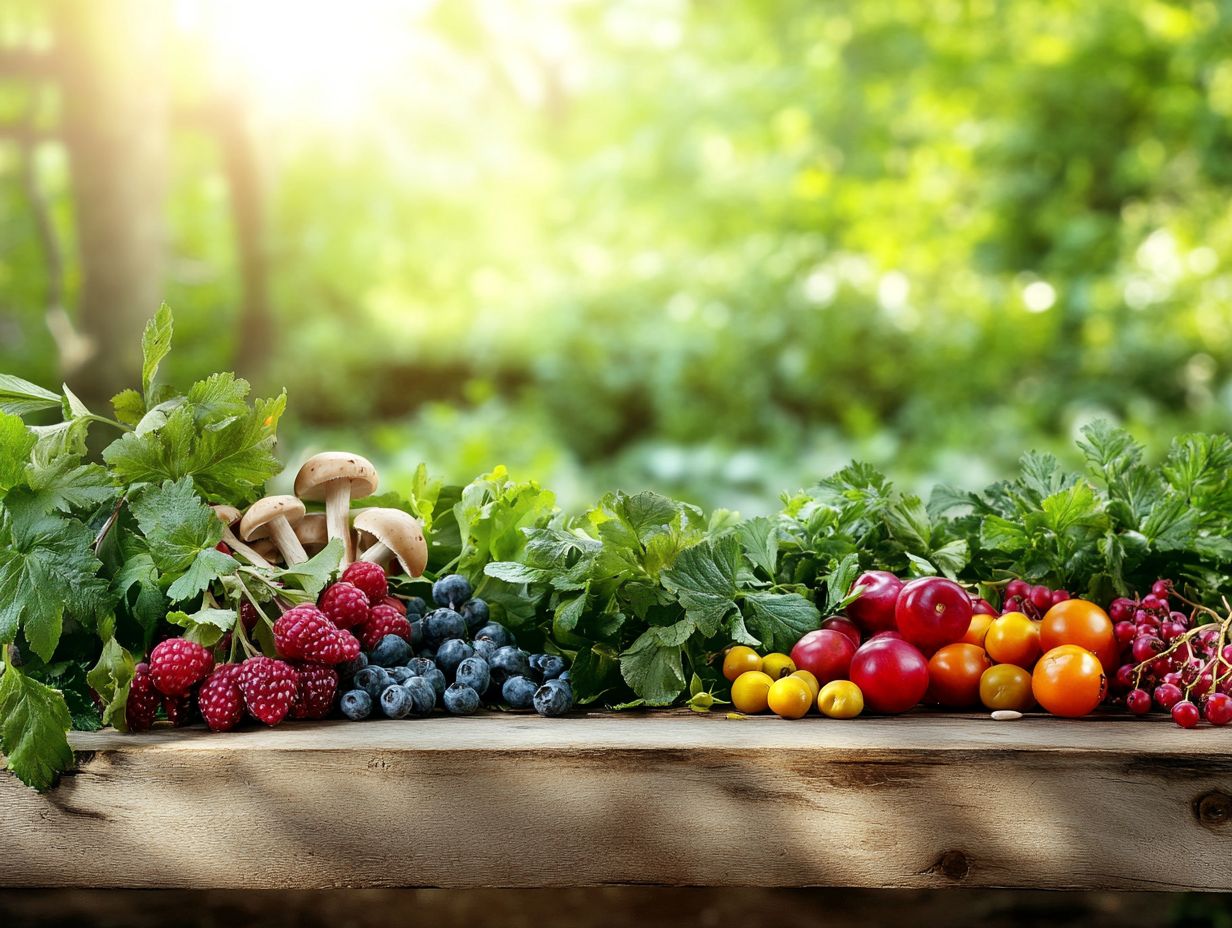
Wild edibles often have higher levels of vitamins, minerals, and antioxidants compared to cultivated produce, highlighting the benefits of foraging for edible plants as a more nutritious option.
Can foraging for wild edibles be dangerous?
Foraging can be risky if you’re not familiar with the plants in your area. It is essential to properly identify plants and avoid consuming anything that may be toxic.
What environmental benefits come from eating wild edibles?
Incorporating wild edibles into your diet supports the preservation of natural habitats and promotes biodiversity, highlighting the importance of wild edibles.
Can wild edibles help with weight management?
Wild edibles are often lower in calories and higher in fiber compared to processed foods, making them a great addition to a weight management plan.
Are there any cultural or historical connections to eating wild edibles?
Eating wild edibles has been part of human culture for centuries, with many indigenous cultures utilizing these plants for medicinal and nutritional purposes. If you’re curious about what wild edibles are, you’ll find that they offer a wealth of benefits.

